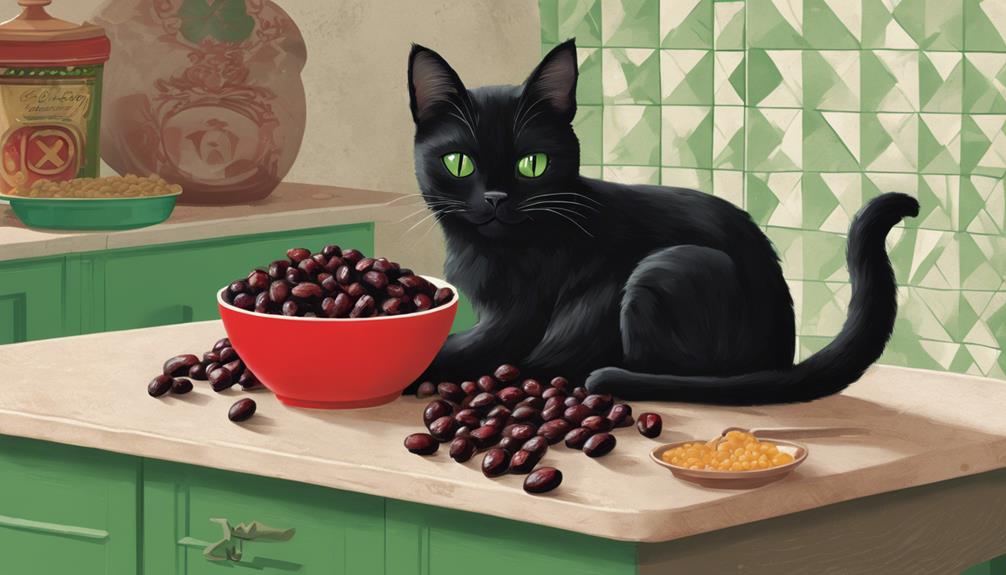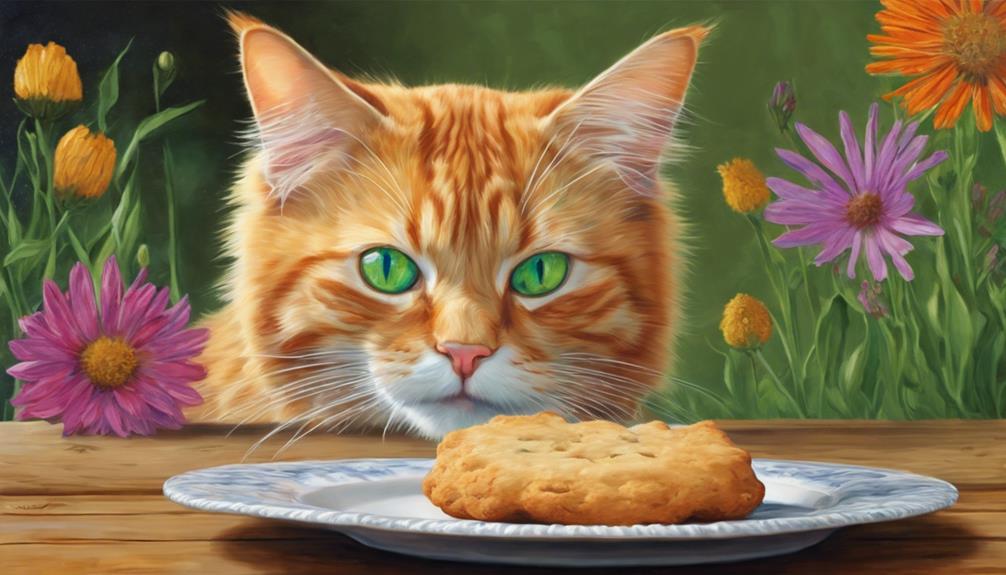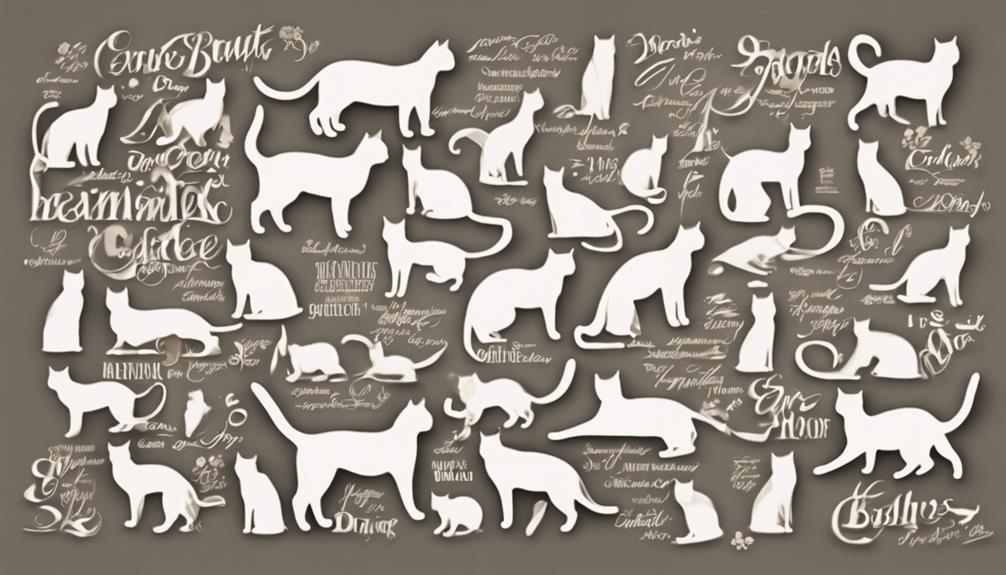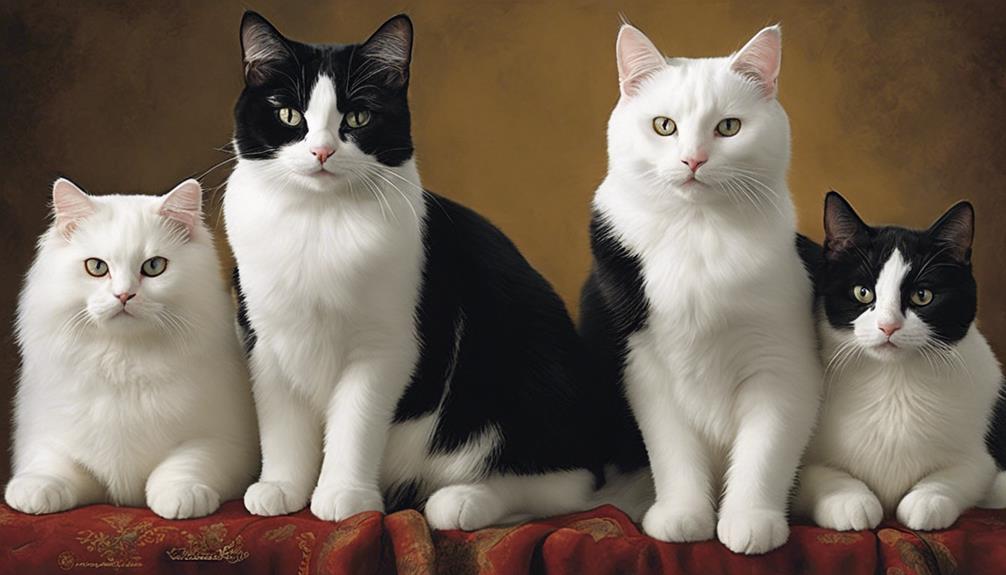If your cat continues to vomit but otherwise appears to be okay, it may suggest underlying problems. Keep a close watch on the frequency, consistency, and color of the vomit. Look out for signs such as hairballs, overeating, and food allergies. Pay attention to when and where your cat vomits to help with an accurate diagnosis. Healthy vomit should be clear, white, or light yellow. If vomiting persists, seek advice from a vet to rule out serious health issues. Consider preventive measures like giving smaller meals, using hairball formula food, and monitoring food consumption. Seeking veterinary attention for persistent or frequent vomiting ensures your cat’s well-being and health.
Key Takeaways
- Monitor vomiting frequency and patterns.
- Consider stress, diet, and food allergies.
- Provide fresh water and balanced diet.
- Consult vet for guidance and diagnostic tests.
- Address underlying health issues promptly.
Understanding Cat Vomiting Behavior
When a cat vomits, it may indicate underlying issues that demand attention. Understanding the reasons behind your cat's vomiting behavior is pivotal in ensuring their well-being.
Cats can vomit due to various factors such as hairballs, overeating, or food allergies. Monitoring the frequency, consistency, and color of the vomit can offer valuable insights into potential underlying causes.
By keeping track of when and where your cat vomits, you provide essential information that can assist the vet in accurately diagnosing the issue. Paying attention to these details can help pinpoint the root cause of your cat's vomiting episodes, guiding you towards appropriate actions to address the problem effectively.
Signs of a Healthy Cat Vomit
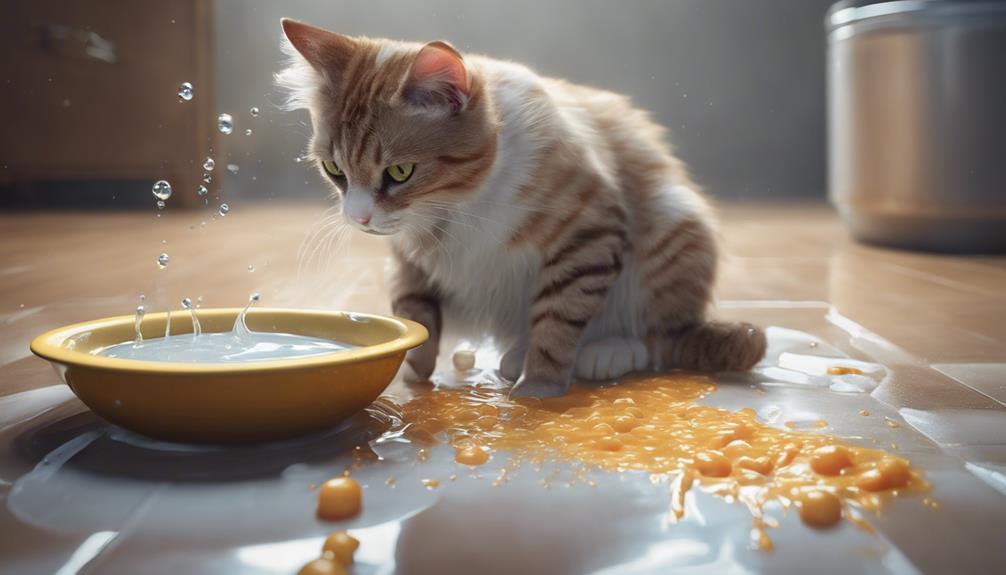
When it comes to evaluating cat vomit, there are key signs to watch for that indicate your feline friend is healthy.
The color of the vomit, how frequently it occurs, and its consistency can give us important clues.
Vomit Color Analysis
When evaluating a cat's vomit color, it is important to note that normal cat vomit usually appears clear, white, or light yellow. Here is a helpful table to guide you in understanding the significance of vomit colors:
| Color | Significance |
|---|---|
| Clear | Indicates water or mucus. |
| White | Commonly seen after consuming milk. |
| Light Yellow | Normal bile color, may suggest an empty stomach. |
Understanding these colors can give you insights into your cat's health. Keep an eye out for any deviations from these normal colors, as they could be indicators of underlying issues. Remember, consistency, undigested food, bile, foul odors, and fast eating habits all play a role in understanding your cat's vomit.
Frequency of Vomiting
Addressing the frequency of vomiting is essential in determining signs of healthy cat vomit. When evaluating your cat's vomit, consider the following:
- Healthy cat vomit should be infrequent, occurring less than once a month.
- Normal cat vomit should be free of blood, bile, or undigested food.
- Healthy cat vomit is usually a single episode with no associated symptoms.
Consistency of Vomit
Monitoring the importance of your cat's vomit is essential in assessing signs of a healthy cat vomit. This includes evaluating its tubular shape and moisture level. Healthy cat vomit typically appears cylindrical, resembling the shape of the esophagus, and should have a damp texture, indicating recent expulsion.
It's normal for cat vomit to contain undigested food, mucus, or even bits of hair. By observing the significance of the vomit, you can gain insights into your cat's digestive health. Remember, a one-off vomiting episode in an otherwise well cat may not be alarming, but keeping an eye on the frequency and consistency of the vomit can help in identifying any underlying issues early on.
Monitoring Vomiting Frequency
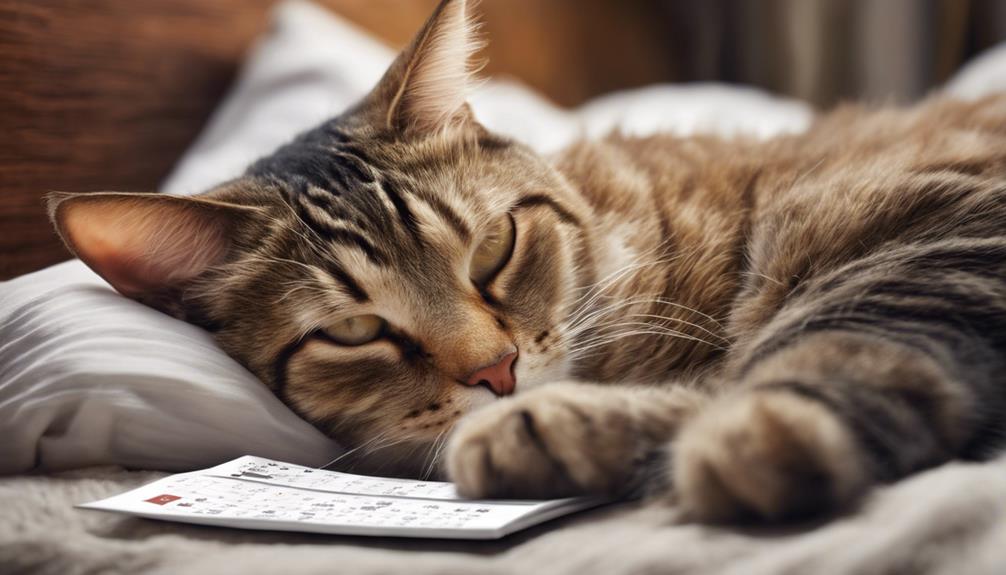
When it comes to addressing a cat that keeps throwing up, monitoring the frequency of vomiting episodes is vital.
By keeping a log and noting any patterns or triggers, we can start to identify potential causes.
Documenting the number of times your cat vomits per day or week can provide valuable insights that may help determine if the vomiting is becoming more frequent or persistent.
Vomiting Frequency Patterns
To effectively track patterns in vomiting frequency, we should maintain a detailed journal documenting the number of times our cat vomits each day or week. By doing so, we can gain valuable insights into our cat's health and provide our vet with essential information for diagnosing any underlying causes.
Here are three key points to contemplate when monitoring vomiting frequency:
- Keep a small notebook handy to jot down the number of vomiting episodes daily.
- Look for any trends in the frequency of vomiting over the course of a week.
- Note any changes in the pattern, such as an increase or decrease in vomiting occurrences.
Consistently monitoring these patterns won't only aid in diagnosing the issue but also help in evaluating the effectiveness of any treatment measures.
Recording Food Intake
Keeping a food diary to track our cat's meals and treats can help identify patterns related to vomiting episodes. By noting the importance of vomiting, we can pinpoint specific triggers or underlying issues that may be causing distress.
It's essential to record the time of day when our cat vomits to see if there's a correlation with meal times or activities. Any changes in our cat's diet or feeding schedule should be documented to assess their impact on vomiting behavior.
Additionally, monitoring the consistency and color of vomit provides valuable information to share with the vet for diagnosis. Tracking meals and treats in a food diary allows us to gather essential data that can aid in understanding our cat's vomiting patterns and overall health.
Potential Causes of Cat Vomiting
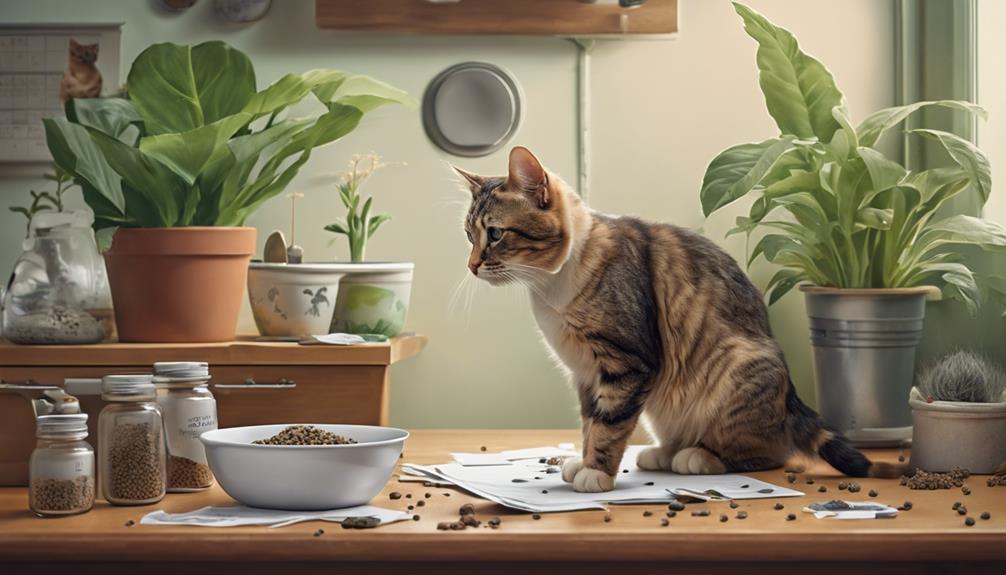
Feline vomiting can be triggered by various factors, including hairballs, overeating, food allergies, and stress. When our furry friends start showing signs of distress through vomiting, it's crucial to take into account these potential causes:
- Hairballs: Especially common in longhaired cats, hairballs can irritate the stomach lining, leading to vomiting episodes.
- Overeating: Cats who eat too quickly or consume more than they should in one sitting may vomit to expel the excess food.
- Food Allergies: Just like humans, cats can also have allergies or intolerances to certain foods, causing them to vomit after eating.
Hairballs as a Common Cause
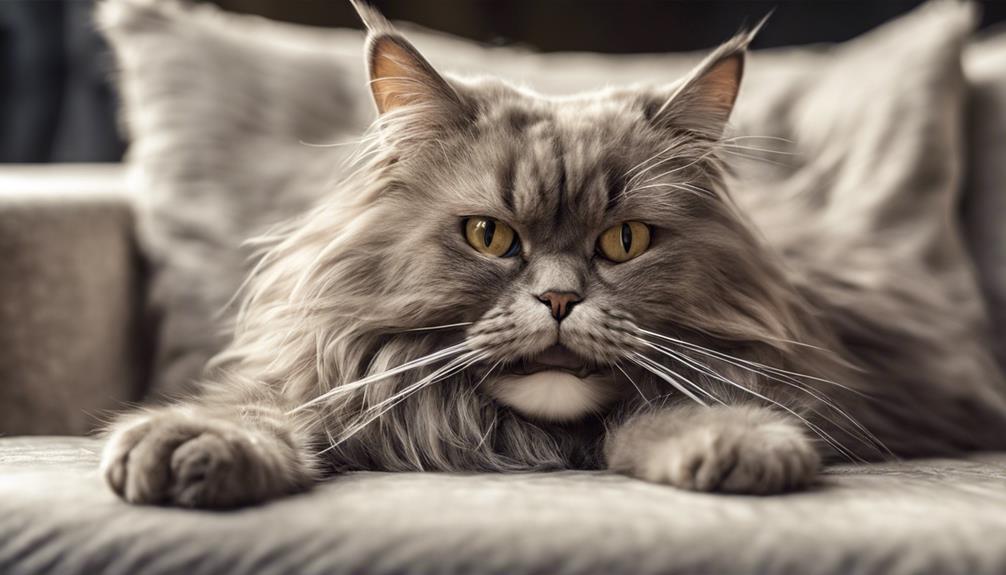
Hairballs are a common culprit behind your cat's vomiting episodes, especially if your feline friend has long fur or grooms excessively. These hair clumps can lead to digestive irritation, prompting your cat to regurgitate.
To prevent hairballs, consider regular grooming and incorporating specialized foods or treats into your cat's diet.
Hairball Prevention Tips
To help prevent hairballs in your cat, daily brushing can play an important role in reducing the ingestion of loose fur. Additionally, incorporating special hairball formula foods or treats into your cat's diet can aid in hairball prevention.
Providing indoor safe alternatives for hunting can also help reduce the formation of hairballs. These measures, coupled with monitoring your cat's grooming habits, can go a long way in managing hairball issues.
Signs of Hairballs
Daily grooming habits play a significant role in managing the signs of hairballs that can affect cats with long fur or frequent grooming behaviors. Cats prone to hairballs may show symptoms such as retching, coughing, or vomiting up cylindrical masses of hair. These telltale signs can indicate the presence of hairballs in your furry friend.
Regular grooming and brushing can help minimize the formation of hairballs by reducing the amount of loose fur ingested during grooming sessions. If left untreated, hairballs can lead to more severe issues, requiring surgical intervention to remove blockages caused by the hairball in the cat's gastrointestinal tract.
Stay vigilant for these signs to ensure your cat's health and well-being.
Hairball Treatment Options
One effective way to address hairball treatment options for cats with long fur or excessive grooming habits involves incorporating specialized foods or treats designed to aid in digestion and prevent hairball formation.
Here are some hairball treatment options worth exploring:
- Specialized Foods: Look for cat foods specifically formulated to help reduce hairball formation.
- Regular Brushing: Gently brushing your cat's fur can help remove loose hair and prevent hairballs.
- Surgery: In severe cases where hairballs cause digestive issues, surgery may be necessary to remove them safely.
Overeating and Diet Issues
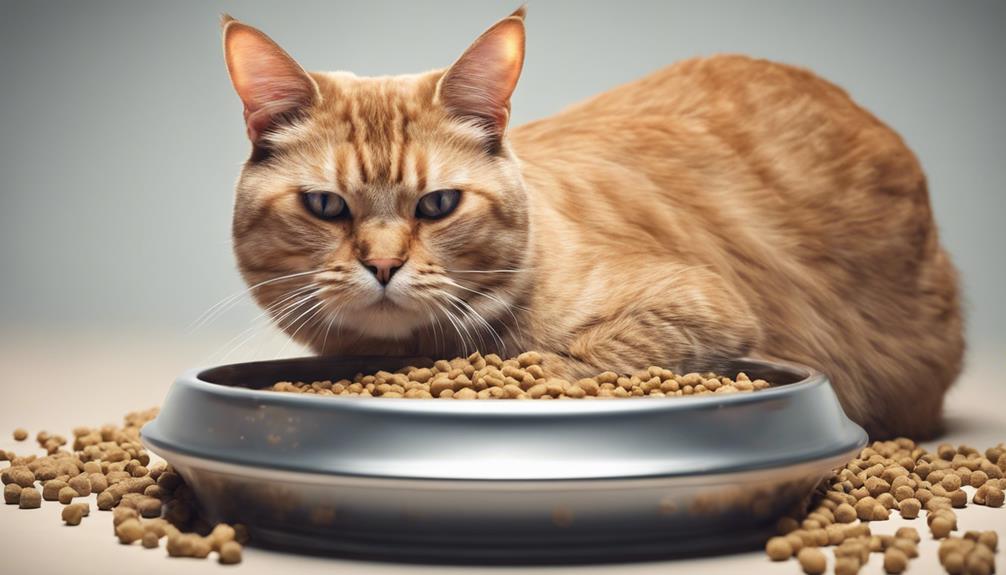
How can we address overeating and diet issues in our cats to prevent vomiting episodes? It's important to monitor your cat's food intake and consider implementing portion control methods to regulate their diet effectively. Introducing a slow feeder or food puzzle can help your feline friend eat at a healthier pace, reducing the likelihood of overeating and subsequent vomiting. Switching to a hairball formula food may also be beneficial, especially if hairballs are a contributing factor to the vomiting episodes. Additionally, ensuring that your cat has a safe environment and access to appropriate indoor hunting alternatives can help reduce stress-related overeating.
| Strategy | Description |
|---|---|
| Portion Control | Regulate food intake to prevent overeating and digestive issues. |
| Slow Feeder | Encourages slower eating habits, reducing the risk of overeating. |
| Hairball Formula | Specifically designed to address hairball-related vomiting issues. |
Exploring Food Allergy Possibilities
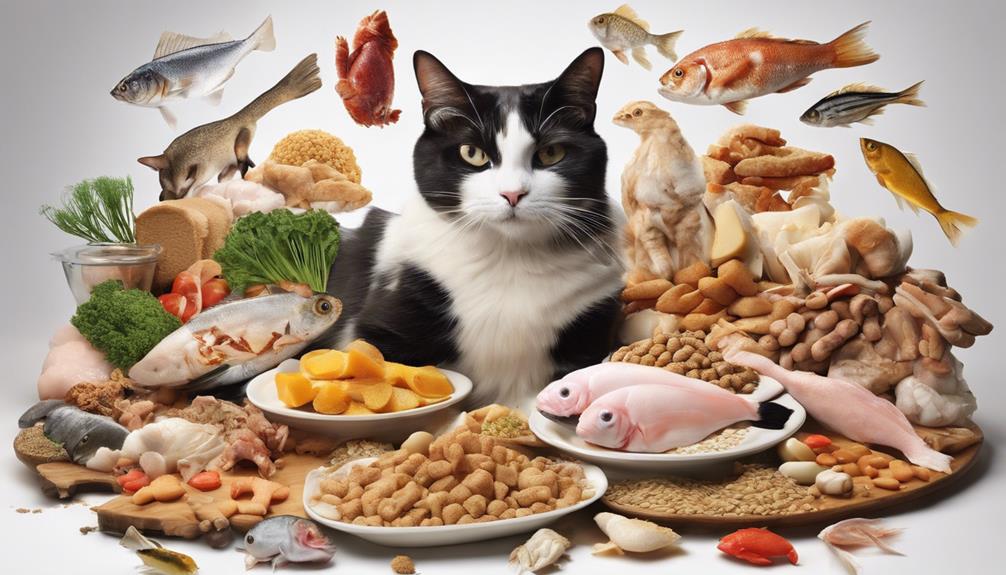
To further investigate potential causes of vomiting in cats, we'll now explore the likelihood of food allergies as a contributing factor. When considering food allergies in cats, it's vital to watch out for specific symptoms that could indicate a problem.
Here are a few key points to keep in mind:
- Common Allergens: Cats can be allergic to various foods such as beef, fish, poultry, and dairy products. These ingredients are known to trigger allergic reactions in sensitive felines.
- Symptoms to Note: Alongside vomiting, cats with food allergies may also exhibit skin problems like itching or redness, as well as digestive issues such as diarrhea or constipation. Keeping an eye out for these signs can help in identifying a potential food allergy.
- Hydrolyzed Protein Diets: In cases where food allergies are suspected, your vet may recommend hydrolyzed protein diets. These specialized diets can help manage allergies by providing proteins in a form that's less likely to trigger a reaction.
If you suspect your cat has food allergies, consulting your vet for a proper diagnosis and tailored treatment plan is essential.
Stress and Its Impact on Cats
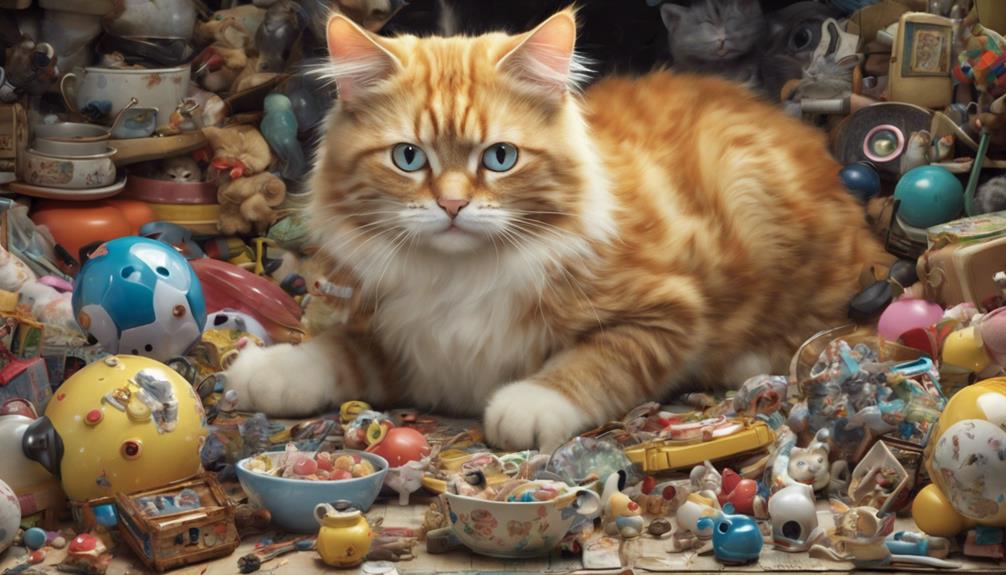
Stress can profoundly influence a cat's well-being and behavior, potentially leading to physical symptoms like vomiting. Signs of stress in cats can range from excessive grooming to changes in litter box habits.
Managing stress through environmental enrichment and positive reinforcement strategies can help alleviate these symptoms and improve your feline friend's overall quality of life.
Stress Affects Cat Behavior
When cats experience stress, their behavior can undergo significant changes, such as increased vocalization or hiding.
- Cats may show aggressive behavior, like hissing or swatting, when they feel stressed.
- Loss of appetite is a common sign of stress in cats, so pay attention to changes in eating habits.
- Stress can also manifest in litter box issues, such as urinating outside the box.
Understanding these signs can help us create a safe environment for our feline friends. By recognizing stress-related behaviors and addressing them promptly, we can help our cats feel more secure and content.
Signs of Cat Stress
During periods of heightened stress, cats may exhibit various behavioral changes that can serve as indicators of their emotional state. Behaviors such as overgrooming, hiding, or aggression could signal that your feline friend is feeling stressed.
It's important to pay attention to these signs because stress in cats can lead to health issues like vomiting, diarrhea, or urinary problems. Factors like environmental changes, loud noises, or the introduction of new pets can trigger stress in cats.
To help alleviate stress, consider using pheromone products or calming techniques. By recognizing and addressing stress in your cat, you can improve their overall well-being and reduce the frequency of vomiting episodes.
Understanding these signs can help you provide the support and care your cat needs.
Managing Cat Stress
Experiencing changes in their environment, routine, or social interactions can trigger stress in cats. When managing cat stress, consider the following:
- Providing a safe space where your cat can retreat to when feeling overwhelmed.
- Engaging in interactive play sessions to help reduce stress and increase bonding.
- Using calming products like pheromone diffusers or calming collars to create a soothing environment.
Understanding your cat's stressors and addressing them can have a substantial impact on their well-being. Chronic stress in cats can contribute to health issues and manifest in behaviors like vomiting.
Serious Health Conditions to Consider
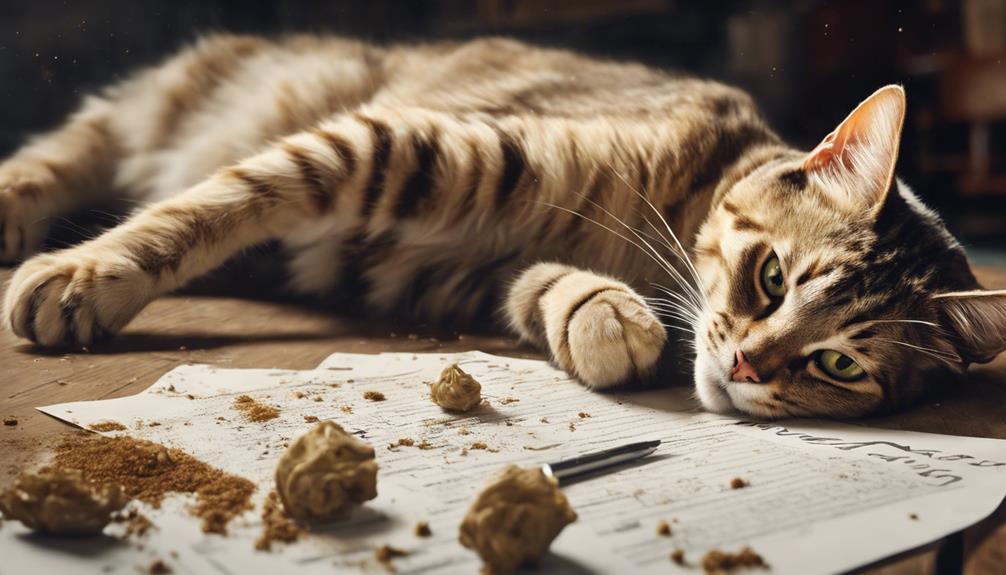
Taking into account serious health conditions like kidney disease or inflammatory bowel disorder is crucial when addressing a cat that keeps throwing up. These underlying issues can lead to persistent vomiting and may require medical attention. Here is a table outlining some serious health conditions to take into account:
| Health Condition | Description | Management |
|---|---|---|
| Kidney Disease | Can cause vomiting due to toxin buildup in the body | Dietary changes, medication |
| Inflammatory Bowel Disorder | Leads to chronic vomiting and gastrointestinal issues | Specialized diet, medication |
| Cancer | Tumors in the digestive system can result in vomiting | Surgery, chemotherapy |
Addressing Inflammatory Bowel Disorders

When looking at cats that keep throwing up, one aspect to focus on is addressing Inflammatory Bowel Disorders, which can manifest as chronic gut inflammation leading to various symptoms. Cats suffering from inflammatory bowel disease may exhibit chronic vomiting, changes in appetite, and lethargy, indicating underlying gut issues that require veterinary attention.
- Symptoms: Keep an eye out for chronic vomiting, changes in appetite, and lethargy in your cat, as these could be signs of inflammatory bowel disease.
- Veterinary Attention: It's essential to seek veterinary care for proper diagnosis and management of inflammatory bowel disorders in cats.
- Treatment: Treatment for inflammatory bowel disease in cats may involve dietary modifications, medications, and close monitoring to guarantee your furry friend's health and well-being.
Identifying Toxins and Chemical Exposure
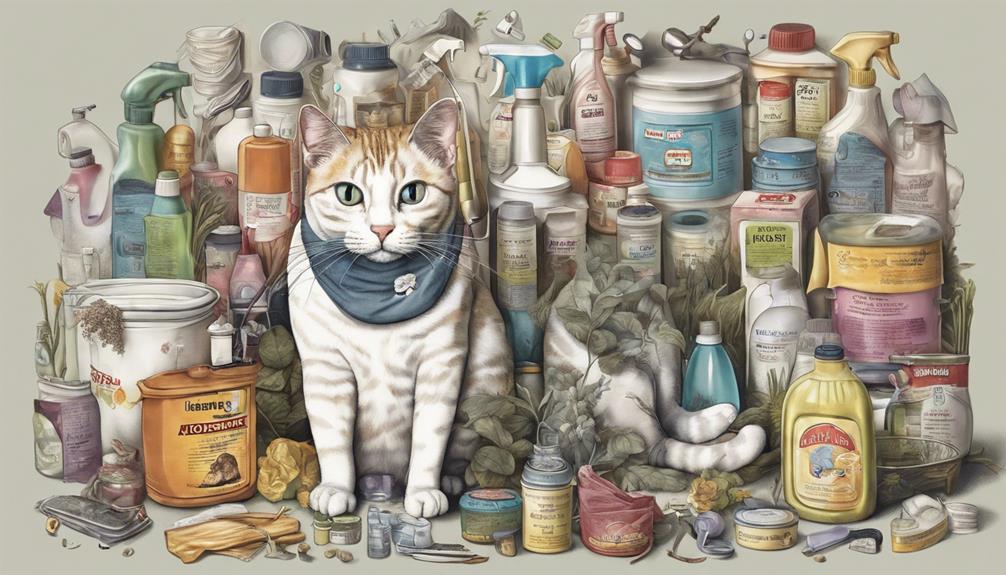
When evaluating a cat's health, it's essential to pinpoint potential toxins and chemical exposures that could be harmful to their well-being. Cats are curious creatures, and they may come into contact with various hazards in our homes. Common household hazards include toxic plants like lilies, foods such as onions and chocolate, and chemicals like cleaning products and antifreeze. Even medications, both prescription and over-the-counter, can pose risks if ingested by your feline friend. If you suspect your cat has been exposed to any of these toxins or chemicals, immediate veterinary attention is vital.
It's important to be vigilant and keep these harmful substances out of reach to prevent accidental poisoning. By being proactive and creating a safe environment for your cat, you can minimize the risk of chemical exposure and ingestion. Remember, quick action is key when it comes to your cat's health and well-being.
Taking Action: Treating Cat Vomiting

We regularly monitor our cat's vomiting frequency and consistency to detect any changes or patterns. When addressing cat vomiting, it's vital to take action promptly.
Here are some steps we can consider:
- Feeding Smaller Meals: Providing smaller, more frequent meals can help prevent overeating, which may reduce the chances of your cat vomiting.
- Consulting the Vet: It's important to consult with your vet to rule out any underlying health issues that could be causing your cat's vomiting. Professional advice can guide you in the right direction.
- Implementing Dietary Changes: Following any dietary changes or medications recommended by your vet can help address your cat's vomiting effectively.
Preventive Measures for Cat Vomiting
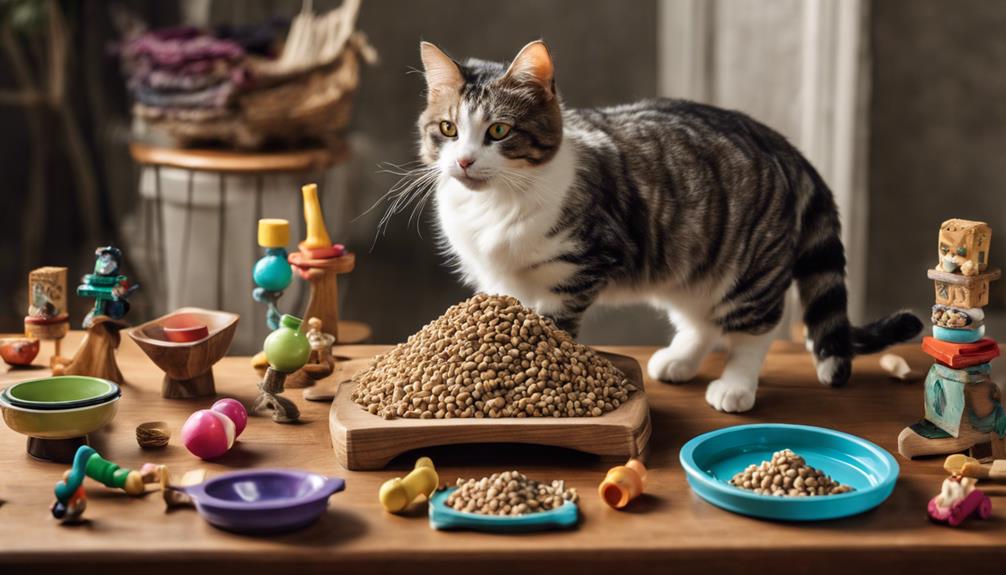
To prevent cat vomiting, it's important to implement proactive measures that can help maintain your cat's digestive health. Monitoring your cat's food intake and considering portion control methods are key in preventing overeating, which can lead to vomiting. Switching to a hairball formula food can help prevent hairballs and reduce the chances of vomiting caused by these issues. Additionally, keeping toxic substances and harmful items out of reach is vital to prevent digestive problems that could result in vomiting.
Regularly monitoring your cat's health and behavior is essential to catch any early signs of potential vomiting. By staying proactive and attentive to your cat's well-being, you can take preventive measures to minimize the occurrence of digestive issues that may lead to vomiting. Taking these steps can contribute to maintaining your cat's overall health and well-being, ensuring they lead a happy and comfortable life free from unnecessary episodes of vomiting.
When to Seek Veterinary Care

Seek veterinary care if your cat exhibits persistent or frequent vomiting despite appearing fine. Consulting a vet is important if your furry friend is experiencing multiple episodes of vomiting in a day or over several days. Immediate attention from a vet becomes necessary if your cat displays signs of weakness, dehydration, or lethargy.
Remember, early intervention plays a crucial role in addressing any underlying health issues that might be causing the vomiting. By seeking timely veterinary care, you can guarantee your cat receives the necessary treatment and support to maintain their well-being.
If you notice blood in their vomit, abdominal pain, or any changes in behavior, don't hesitate to schedule a visit to the vet. Your cat's health is paramount, and addressing these symptoms promptly can help in diagnosing and managing any potential issues effectively.
Ensuring Your Cats Well-being
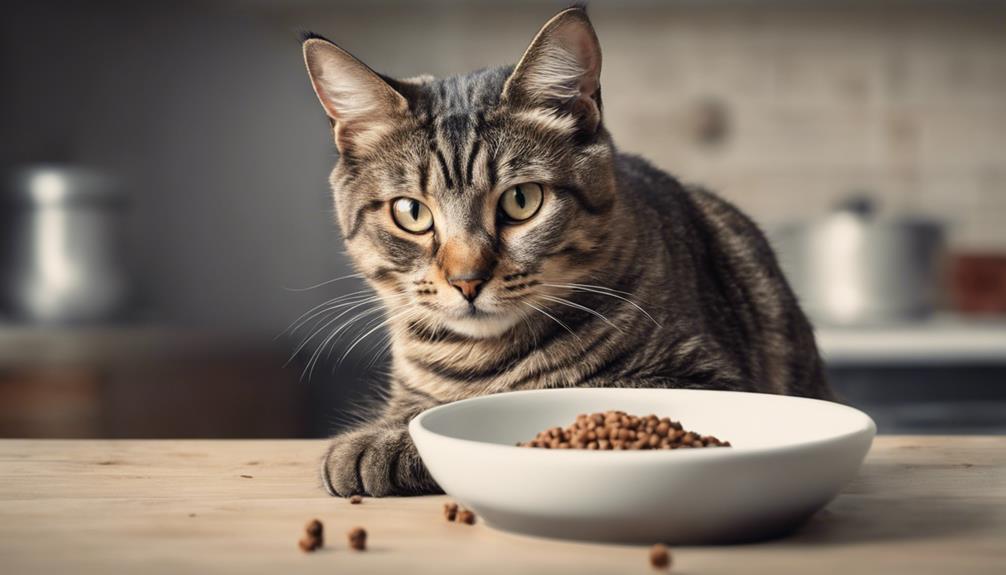
Monitoring your cat's behavior for any signs of distress or discomfort is essential in ensuring their well-being. Keep a close eye on any changes in their eating habits, litter box use, energy levels, or grooming routine. By staying attentive to these details, you can better understand your cat's overall health status. Additionally, tracking the frequency and patterns of vomiting episodes can provide valuable information to share with your vet during consultations. Consider factors like stress, diet changes, or potential food allergies that could be contributing to your cat's vomiting. Ensuring your cat has access to fresh water and a balanced diet is crucial for supporting their overall health and well-being. Consulting with your vet for further guidance and potential diagnostic tests can help address any underlying health issues causing the vomiting. Below is a table summarizing key points to help you maintain your cat's health:
| Aspect | Importance | Action |
|---|---|---|
| Diet | Essential for overall health | Provide balanced meals |
| Water intake | Critical for hydration | Guarantee fresh water supply |
| Veterinary visits | Regular check-ups are crucial | Schedule appointments |
Frequently Asked Questions
What if My Cat Keeps Throwing up but Is Fine?
If my cat keeps throwing up but seems fine, we must monitor for other symptoms and possible triggers. Keeping track of patterns helps our vet assess the situation accurately. It's vital to address persistent vomiting promptly for our cat's health.
How Do You Help a Cat That Keeps Throwing Up?
When a cat keeps throwing up, provide small, bland meals, monitor behavior for distress, keep track of vomiting frequency, and make sure hydration. Seek advice from a vet to rule out health issues. We can assist your cat in feeling better.
Why Is My Cat Throwing up Undigested Food but Acting Normal?
We comprehend the concern when our kitty companions regurgitate undigested food but behave as if nothing's amiss. It's like a puzzle piece that doesn't quite fit. Observing their routines and seeking advice from a vet are vital steps for their well-being.
How Do You Treat a Sick Cat Without Going to the Vet?
We monitor behavior, offer water, and easy-to-digest food, keep kitty comfy, and consult a vet. Seek immediate care for distress. Always prioritize our fur baby's health and well-being, even when treating at home.
Is Lethargy a Common Symptom of Cats Throwing Up?
If your cat is throwing up, it’s important to pay attention to their behavior. Understanding cat lethargy symptoms can help you determine if something more serious is going on. Lethargy, along with vomiting, could indicate a health issue that needs to be addressed by a veterinarian.
Conclusion
To wrap up, if your cat keeps regurgitating but appears healthy, it's crucial to observe their behavior, inspect for indicators of a normal vomit, and be mindful of potential triggers. Take steps by addressing hairballs and putting in place preventive measures.
Bear in mind, when uncertain, seek veterinary attention to guarantee your cat's well-being. And always remember, cats may have nine lives, but they can't endure endless episodes of vomiting!



